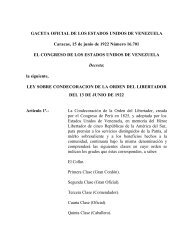Transverse waves on a string - People.fas.harvard.edu
Transverse waves on a string - People.fas.harvard.edu
Transverse waves on a string - People.fas.harvard.edu
You also want an ePaper? Increase the reach of your titles
YUMPU automatically turns print PDFs into web optimized ePapers that Google loves.
4.3. IMPEDANCE 15<br />
Why Fy is proporti<strong>on</strong>al to √ T µ<br />
We saw above that the transverse force that the left <strong>string</strong> (or technically the ring at the<br />
boundary) applies to the right <strong>string</strong> is Fy = +bvy ≡ Zvy. So if you replace the left <strong>string</strong><br />
with your hand, then Fy = Zvy is the transverse force than you must apply to the right<br />
<strong>string</strong> to give it the same moti<strong>on</strong> that it had when the left <strong>string</strong> was there. The impedance<br />
Z gives a measure of how hard it is to wiggle the end of the <strong>string</strong> back and forth. It is<br />
therefore reas<strong>on</strong>able that Z = √ T2µ2 grows with both T2 and µ2. In particular, if µ2 is<br />
large, then more force should be required in order to wiggle the <strong>string</strong> in a given manner.<br />
However, although this general dependence <strong>on</strong> µ2 seems quite intuitive, you have to be<br />
careful, because there is a comm<strong>on</strong> incorrect way of thinking about things. The reas<strong>on</strong> why<br />
the force grows with µ2 is not the same as the reas<strong>on</strong> why the force grows with m in the<br />
simple case of a single point mass (with no <strong>string</strong> or anything else attached to it). In that<br />
case, if you wiggle a point mass back and forth, then the larger the mass, the larger the<br />
necessary force, due to F = ma.<br />
But in the case of a <strong>string</strong>, if you grab <strong>on</strong>to the leftmost atom of the right part of the<br />
<strong>string</strong>, then this atom is essentially massless, so your force isn’t doing any of the “F = ma”<br />
sort of accelerati<strong>on</strong>. All your force is doing is simply balancing the transverse comp<strong>on</strong>ent of<br />
the T2 tensi<strong>on</strong> that the right <strong>string</strong> applies to its leftmost atom. This transverse comp<strong>on</strong>ent<br />
is n<strong>on</strong>zero due to the (in general) n<strong>on</strong>zero slope. So as far as your force is c<strong>on</strong>cerned, all<br />
that matters are the values of T2 and the slope. And the slope is where the dependence<br />
<strong>on</strong> µ2 comes in. If µ2 is large, then v2 = T2/µ2 is small, which means that the wave in<br />
the right <strong>string</strong> is squashed by a factor of v2/v1 compared with the wave <strong>on</strong> the left <strong>string</strong>.<br />
This then means that the slope of the right part is larger by a factor that is proporti<strong>on</strong>al<br />
to 1/v2 = µ2/T2, which in turn means that the transverse force is larger. Since the<br />
transverse force is proporti<strong>on</strong>al to the product of the tensi<strong>on</strong> and the slope, we see that it<br />
is proporti<strong>on</strong>al to T2 µ2/T2 = √ T2µ2. To sum up: µ2 affects the impedance not because<br />
of an F = ma effect, but rather because µ affects the wave’s speed, and hence slope, which<br />
then affects the transverse comp<strong>on</strong>ent of the force.<br />
A byproduct of this reas<strong>on</strong>ing is that the dependence of the transverse force <strong>on</strong> T2 takes<br />
the form of √ T2. This comes from the expected factor of T2 which arises from the fact<br />
that the transverse force is proporti<strong>on</strong>al to the tensi<strong>on</strong>. But there is an additi<strong>on</strong>al factor<br />
of 1/ √ T2, because the transverse force is also proporti<strong>on</strong>al to the slope, which behaves like<br />
1/ √ T2 from the argument in the previous paragraph.<br />
Why Fy is proporti<strong>on</strong>al to vy<br />
We saw above that if the right <strong>string</strong> is removed and if the ring is attached to a pist<strong>on</strong> with<br />
a damping coefficient of b = √ T2µ2, then the left <strong>string</strong> can’t tell the difference. Either way,<br />
the force <strong>on</strong> the left <strong>string</strong> takes the form of −bvy ≡ −b ˙y. If instead of a pist<strong>on</strong> we attach<br />
the ring to a transverse spring, then the force that the ring applies to the left <strong>string</strong> (which<br />
equals the force that the spring applies to the ring, since the ring is massless) is −ky. And<br />
if the ring is instead simply a mass that isn’t attached to anything, then the force it applies<br />
to the left <strong>string</strong> is −m¨y (equal and opposite to the Fy = may force that the <strong>string</strong> applies<br />
to the mass). Neither of these scenarios mimics the correct −b ˙y force that the right <strong>string</strong><br />
actually applies.<br />
This −b ˙y force from the right <strong>string</strong> is a c<strong>on</strong>sequence of the “wavy-ness” of <str<strong>on</strong>g>waves</str<strong>on</strong>g>, for<br />
the following reas<strong>on</strong>. The transverse force Fy that the right <strong>string</strong> applies to the ring is<br />
proporti<strong>on</strong>al to the slope of the wave; it equals the tensi<strong>on</strong> times the slope, assuming the<br />
slope is small:<br />
∂ψR<br />
Fy = T2 . (42)<br />
∂x

















